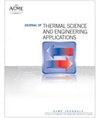超临界压力煤油与压缩空气在逆流中的换热与热氧化结焦计算研究
IF 1.4
4区 工程技术
Q3 ENGINEERING, MECHANICAL
引用次数: 0
摘要
冷却空气(CCA)技术是一种有效的方法,在先进的燃气涡轮发动机降低高度压缩空气的温度和恢复其冷却能力,使用机载燃料作为冷却剂。本文对超临界航空煤油与压缩高温空气在双管逆流配置下的热交换进行了数值研究,以供CCA应用。采用多步反应机理研究了煤油的热氧化反应和表面焦化反应。结果表明,确定风管直径不仅可以在传热和压力损失方面改善空气侧的整体热性能,而且还可以在燃料侧适当限制最高温度,以避免煤油的强烈热解化学反应和由此产生的快速表面焦化过程。虽然肋状和窝状表面结构都能改善燃料管的整体热性能,增加整体空气温度的降低,但它们也会导致煤油热氧化反应引起的表面结焦速率增加。热氧化结焦过程会逐渐增大换热屏障,对换热器的长期运行造成不利影响。本文所得到的数值结果对CCA的应用具有基础和实际意义。本文章由计算机程序翻译,如有差异,请以英文原文为准。
Computational study of heat exchange and thermal oxidative coking of supercritical-pressure kerosene with compressed air in counter flows
The Cooled Cooling Air (CCA) technology is an effective approach in an advanced gas turbine engine to reduce the temperature of the highly compressed air and recover its cooling capacity, using the onboard fuel as coolant. Numerical studies have been conducted in this paper to analyze heat exchange between the supercritical-pressure aviation kerosene and the compressed high-temperature air in a double-pipe counter flow configuration, intended for the CCA applications. The thermal oxidative reactions and surface coking of kerosene are taken into consideration using a multi-step reaction mechanism. Results indicate that the air tube diameter should be determined to obtain not only the improved overall thermal performance on the air side, in terms of both heat transfer and pressure loss, but also the properly limited maximum temperature on the fuel side to avoid the strong pyrolytic chemical reactions of kerosene and the resulting fast surface coking process. Although the ribbed and dimpled surface structures are both able to improve the overall thermal performance in the fuel tube and increase the bulk air temperature reduction, they also lead to the increased surface coking rate from the thermal oxidative reactions of kerosene. The thermal oxidative coking process would gradually increase heat transfer barrier and cause an adverse effect on the long-term operation of a heat exchanger. The numerical results obtained in this paper should have fundamental and practical importance in the CCA applications.
求助全文
通过发布文献求助,成功后即可免费获取论文全文。
去求助
来源期刊

Journal of Thermal Science and Engineering Applications
THERMODYNAMICSENGINEERING, MECHANICAL -ENGINEERING, MECHANICAL
CiteScore
3.60
自引率
9.50%
发文量
120
期刊介绍:
Applications in: Aerospace systems; Gas turbines; Biotechnology; Defense systems; Electronic and photonic equipment; Energy systems; Manufacturing; Refrigeration and air conditioning; Homeland security systems; Micro- and nanoscale devices; Petrochemical processing; Medical systems; Energy efficiency; Sustainability; Solar systems; Combustion systems
 求助内容:
求助内容: 应助结果提醒方式:
应助结果提醒方式:


